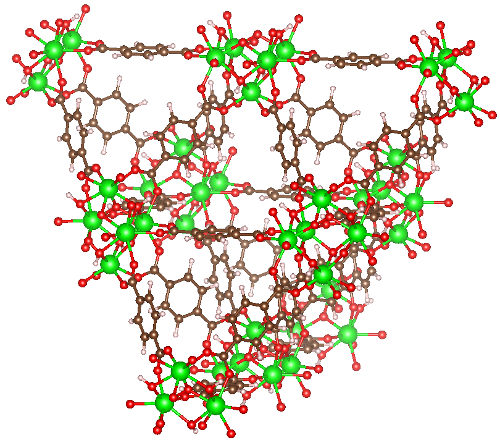Accurate electronic-structure investigation of the role of dispersion in competitive water adsorption in a rigid metal-organic framework
Accurate electronic-structure investigation of the role of dispersion in competitive water adsorption in a rigid metal-organic framework
Promotor(en): V. Van Speybroeck /16NANO12 / Nanoporous materialsMetal-organic frameworks (MOFs) are crystalline materials that consist of metal oxide clusters connected by organic linkers. This results in 1D, 2D or 3D repeated structures with large cavities, i.e. periodic porous structures. The pores allow confining chemical species for several industrially relevant applications, such as gas storage, gas separation or catalysis. To obtain an efficient MOF, it is therefore important that the metal nodes and organic linkers are suitably chosen to obtain an ideal combination of adsorption properties.
UiO-66(Zr) is one of the most stable frameworks, displaying high thermal, chemical and mechanical stability. This is due to its zirconium oxide clusters with strong Zr-O bonds, which are surrounded by easily re-arrangeable benzene dicarboxylate (BDC) linkers (see figure). Although these structural features make UiO-66(Zr) stable in humid conditions as well, this does not mean that water may not have unwanted effects. Indeed, the adsorption of water vapour in the UiO-66 material competes with that of other gases, considerably influencing the gas storage capabilities and selectivity of the framework. Some other metals (e.g., Hf instead of Zr) or functionalized linkers (e.g. BDC functionalized with monomethyl or dimethyl) have already shown improved properties with respect to standard UiO-66, but we still need to do better.

It is hard to experimentally screen a large number of possible framework modifications for an optimal interaction with water. Modelling the adsorption of several gases, in competition with water, is a better alternative. However, many gases of interest are apolar (e.g. H2, N2) and mainly adsorb through dispersive interactions with the UiO-66 framework. The simulation method therefore needs to be able to correctly describe dispersive interactions within the framework. In addition, the investigation of several metal nodes and linker modifications requires an approach that is fully transferable between the different systems. For this, methods based on quantum mechanics are best suited.
Goal
This Master's thesis aims to investigate the adsorption energy of several gas molecules in UiO-66 type MOFs, in competition with water. You will use density-functional theory (DFT), a method based on quantum mechanics and implemented in the VASP program. However, regular DFT approaches do not describe dispersion effects well. Researchers have therefore recently proposed a number of strategies to remedy this shortcoming (DFT-D3, vdW-DF2, DFT-TS, ...). As a first step, you will need to test which of these strategies works best. To do this, you can look at the adsorption of hydrogen, nitrogen, CO2 and water in UiO-66 and compare to experimental data. A second step then consists in combining water with other gas molecules and studying how the competition with water influences the adsorptive properties of UiO-66. Finally, you will test a number of different metal nodes and linker functionalizations to improve the selectivity of UiO-66 for several gases over water. In each of these steps, it will be important to correctly describe the positions of the adsorbed molecules. The optimization of these positions may be performed using classical force fields, a topic on which the CMM has much expertise.
Context for Engineering Physics students
Physics: use of quantum mechanical models for materials modelling
Engineering: application to the properties of nanoporous materials
- Study programmeMaster of Science in Engineering Physics [EMPHYS], Master of Science in Physics and Astronomy [CMFYST]ClustersFor Engineering Physics students, this thesis is closely related to the cluster(s) MODELING, MATERIALS, NANORecommended coursesSimulations and Modeling for the Nanoscale, Computational Materials Physics

